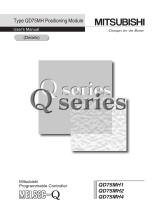
− IV −
8.1.2 Parameter list ............................................................................................................................ 8- 5
(1) Unit setting......................................................................................................................... 8- 5
(2) Roller diameter (L) / Number of PULSES per roller revolution(N
L
)................................... 8- 5
(3) Permissible droop pulse value .......................................................................................... 8- 6
(4) Speed control limit (V
L
) ..................................................................................................... 8- 6
(5) Torque limit value setting device (1 word)......................................................................... 8- 6
(6) Comment........................................................................................................................... 8- 6
8.2 Ball Screws....................................................................................................................................... 8- 7
8.2.1 Ball screw operation .................................................................................................................. 8- 7
(1) Operation........................................................................................................................... 8- 7
(2) Control details.................................................................................................................... 8- 7
8.2.2 Parameter list ............................................................................................................................ 8- 8
(1) Unit setting......................................................................................................................... 8- 8
(2) Ball screw pitch (P) / Number of PULSES per ball screw revolution (N
P
)......................... 8- 8
(3) Permissible droop pulse value .......................................................................................... 8- 9
(4) Stroke limit upper limit value/lower limit value................................................................... 8- 9
(5) Speed limit value (V
L
)........................................................................................................ 8- 9
(6) Limit switch output............................................................................................................. 8- 9
(7) Torque limit value setting device (1 word)........................................................................ 8-10
(8) Comment.......................................................................................................................... 8-10
8.3 Rotary Tables.................................................................................................................................. 8-11
8.3.1 Rotary table operation.............................................................................................................. 8-11
(1) Operation.......................................................................................................................... 8-11
(2) Control details................................................................................................................... 8-11
8.3.2 Parameter list ........................................................................................................................... 8-12
(1) Number of PULSES per rotary table revolution (N
D
)........................................................ 8-12
(2) Permissible droop pulse value ......................................................................................... 8-12
(3) Stroke limit upper limit value/lower limit value.................................................................. 8-12
(4) Speed limit value (V
L)
....................................................................................................... 8-13
(5) Limit switch output............................................................................................................ 8-13
(6) Torque limit value setting device (1 word)........................................................................ 8-13
(7) Comment.......................................................................................................................... 8-13
(8) Virtual axis present value in one revolution storage device
(main shaft side)(2 words)................................................................................................ 8-14
(9) Virtual axis present value in one revolution storage device
(auxiliary input shaft side)(2 words).................................................................................. 8-16
8.4 Cams............................................................................................................................................... 8-18
8.4.1 Cam operation.......................................................................................................................... 8-19
(1) Procedure for switching from the REAL mode to the VIRTUAL mode............................. 8-19
(2) Processing on switching from the REAL mode to the VIRTUAL mode............................ 8-19
(3) Operation.......................................................................................................................... 8-19
(4) Switching the stroke and cam No. during operation......................................................... 8-20
(5) Control details................................................................................................................... 8-21
(6) Changing control .............................................................................................................. 8-22
(7) Example sequence program ............................................................................................ 8-22






















